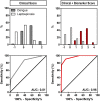Host biomarkers distinguish dengue from leptospirosis in Colombia: a case-control study
- PMID: 24444080
- PMCID: PMC3909480
- DOI: 10.1186/1471-2334-14-35
Host biomarkers distinguish dengue from leptospirosis in Colombia: a case-control study
Abstract
Background: Dengue fever and leptospirosis have partially overlapping geographic distributions, similar clinical presentations and potentially life-threatening complications but require different treatments. Distinguishing between these cosmopolitan emerging pathogens represents a diagnostic dilemma of global importance. We hypothesized that perturbations in host biomarkers can differentiate between individuals with dengue fever and leptospirosis during the acute phase of illness.
Methods: We randomly selected subjects from a prospective cohort study of acute febrile illness in Bucaramanga, Colombia and tested 19 serum biomarkers by ELISA in dengue fever (DF, n = 113) compared to subjects with leptospirosis (n = 47). Biomarkers were selected for further analysis if they had good discriminatory ability (area under the ROC curve (AUC) >0.80) and were beyond a reference range (assessed using local healthy controls).
Results: Nine biomarkers differed significantly between dengue fever and leptospirosis, with higher levels of Angptl3, IL-18BP, IP-10/CXCL10, Platelet Factor 4, sICAM-1, Factor D, sEng and sKDR in dengue and higher levels of sTie-2 in leptospirosis (p < 0.001 for all comparisons). Two biomarkers, sEng and IL18BP, showed excellent discriminatory ability (AUROC >0.90). When incorporated into multivariable models, sEng and IL18BP improved the diagnostic accuracy of clinical information alone.
Conclusions: These results suggest that host biomarkers may have utility in differentiating between dengue and leptospirosis, clinically similar conditions of different etiology.
Figures



Similar articles
-
Host biomarkers are associated with progression to dengue haemorrhagic fever: a nested case-control study.Int J Infect Dis. 2015 Nov;40:45-53. doi: 10.1016/j.ijid.2015.07.027. Epub 2015 Aug 6. Int J Infect Dis. 2015. PMID: 26255888
-
New parameters available on Sysmex XE-5000 hematology analyzers contribute to differentiating dengue from leptospirosis and enteric fever.Int J Lab Hematol. 2015 Dec;37(6):861-8. doi: 10.1111/ijlh.12422. Epub 2015 Sep 3. Int J Lab Hematol. 2015. PMID: 26333341
-
Protein Carbonyl as a Biomarker of Oxidative Stress in Severe Leptospirosis, and Its Usefulness in Differentiating Leptospirosis from Dengue Infections.PLoS One. 2016 Jun 9;11(6):e0156085. doi: 10.1371/journal.pone.0156085. eCollection 2016. PLoS One. 2016. PMID: 27280281 Free PMC article.
-
Leptospirosis in humans.Curr Top Microbiol Immunol. 2015;387:65-97. doi: 10.1007/978-3-662-45059-8_5. Curr Top Microbiol Immunol. 2015. PMID: 25388133 Free PMC article. Review.
-
Molecular Diagnosis as an Alternative for Public Health Surveillance of Leptospirosis in Colombia.Microorganisms. 2023 Nov 13;11(11):2759. doi: 10.3390/microorganisms11112759. Microorganisms. 2023. PMID: 38004770 Free PMC article. Review.
Cited by
-
Demographic and clinical risk factors associated with severity of lab-confirmed human leptospirosis in Colombia, 2015-2020.PLoS Negl Trop Dis. 2023 Jul 5;17(7):e0011454. doi: 10.1371/journal.pntd.0011454. eCollection 2023 Jul. PLoS Negl Trop Dis. 2023. PMID: 37406001 Free PMC article.
-
Antibodies against Mycobacterial proteins as biomarkers for HIV-associated smear-negative tuberculosis.Clin Vaccine Immunol. 2014 Jun;21(6):791-8. doi: 10.1128/CVI.00805-13. Epub 2014 Mar 26. Clin Vaccine Immunol. 2014. PMID: 24671553 Free PMC article.
-
A Rare Complication of Leptospirosis: Weil's Disease Diagnosed in the United States.Cureus. 2023 Aug 17;15(8):e43620. doi: 10.7759/cureus.43620. eCollection 2023 Aug. Cureus. 2023. PMID: 37719584 Free PMC article.
-
Elevated Plasma Angiopoietin-like 4 Protein Levels in Adult Patients with Dengue.Viruses. 2025 Feb 6;17(2):226. doi: 10.3390/v17020226. Viruses. 2025. PMID: 40006981 Free PMC article.
-
Inflammatory molecules expression pattern for identifying pathogen species in febrile patient serum.Exp Ther Med. 2016 Jul;12(1):312-318. doi: 10.3892/etm.2016.3323. Epub 2016 May 10. Exp Ther Med. 2016. PMID: 27347055 Free PMC article.
References
-
- World Health Organization. Dengue and dengue hemorrhagic fever. 2012. Fact sheet 117.
-
- Thomas L, Verlaeten O, Cabie A, Kaidomar S, Moravie V, Martial J, Najioullah F, Plumelle Y, Fonteau C, Dussart P. et al.Influence of the dengue serotype, previous dengue infection, and plasma viral load on clinical presentation and outcome during a dengue-2 and dengue-4 co-epidemic. The American journal of tropical medicine and hygiene. 2008;14(6):990–998. - PubMed
Publication types
MeSH terms
Substances
Grants and funding
LinkOut - more resources
Full Text Sources
Other Literature Sources
Medical
Miscellaneous

